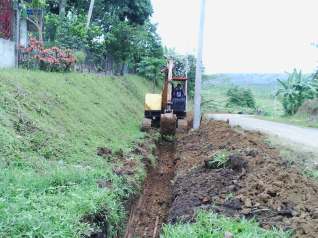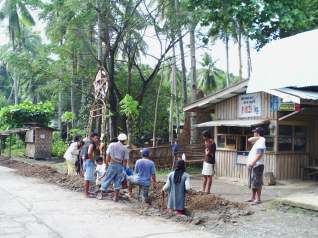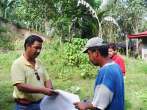Microsoft word - lgrep newsletter no.17 _dec 2008_ a4 version




C -DIDP LOCAL GOVERNANCE AND RURAL EMPOWERMENT PROJECT FOR DAVAO REGION
For Inquiry: Project Management Office (PMO) Davao Integrated Development Program
Ground Flr., JFM Corporate Center
848 Atis St., Juna Subd. Matina, 8000 Davao City
Tel : (82) 297-0058
No. 17 (December 2008)
Fax : (82) 297-1258
E-mail : [email protected]
WATER SUPPLY CONSTRUCTION
IN BRGY. WAAN BEGUN
BY GUSTAVO C. CUERPO, JR.
Last Dec. 15, 2008, the Contractor for
the Davao City Pilot Project, All Trade Resourc
es, mobilized their workforce in
Barangay Waan in accordance with their
revised work schedule.
Durin g the first day, the bunkhouse was
built close to the tank site and a
preliminary staking of the pipeline was conducte d simultaneous with the site
clearing of some WS facilities. On the next
day, backhoe equipment was mobilized to start the excavation work for the foundation
of the tank. Afterwards, the equipment was transferr
ed to continue excavation work for
the transmission line from the Tank site up
to the Well No. 2.
Some local residents were employed by
the Contractor to undertake excavation
equipme nt job; the work is easily delivered as they have not encountered some
problems on site while doing the activities.
Despite the long holiday season, the
Contractor took only one day off (Dec 25) and kept
on working at site to keep up with
A backhoe excavates for pipeline nearby a post in Purok 12.
the work schedule; the Project Engineer is
always there to closely supervise the activities . At the same time, JICA WS Supervisor conducted regular inspection of
the Contractor activities to ensure that the work is in accordance with the plans, specifications and work schedule.
At the end of December 2008, the
Contract or work accomplishment was
evaluated at 8.57%. (more photos on page
The excavation for the Elevated Tank
Excavation works for the pipeline were done by the community as their counterpart.
foundation being monitored by Engr. Cuerpo.




No. 17 (December 2008)
Groundwater activity updates…
BY MICHAEL C. NACPIL
The next phase in the program for
Groundwa ter Development is the well drillings in the pilot sites. These included
Electric L ogging and series of Pumping Tests.
For Davao del Norte, the cutting
samples c ollected from the drilled wells
in Brgy. Alejal, Carmen confirmed the
result of the geo-resistivity test that we conducted in the previous months. For
Well#02, we found a potential aquifer below 40 m depth but its properties included high salinity with dissolved
gasses making it potentially flammable so we decide d to seal the borehole to avoid possible mishaps. For Well#03 which had
a 65m depth, the borehole electric log test showed th at we can use an aquifer from a depth of 10m to 21m, and the pumping
test showed that it will yield not less than 4.0 liters per second of water. On the
other hand, the drilling in Well#01 is cancelled
since it is very near to Well#02
Groundwater workshop on modeling and database held last December 9-10 at Amigoas Cafe
so it's highly probable that it also has
dissolved gasses. A geo-resistivity survey
On the other hand, the yield of Well#03 is
The mobilization in Davao Oriental
will be c onducted in January 2009 to
4.1 l/s while Well#01 has at least 5.0 l/s
will be on January 2009. Completion of
determine the location of the replacement
and a 0.5 l/s free-flowing discharge as
other groundwater activities for the pilot
measured using the 60° triangular weir.
sites is scheduled on February 2009.
The pil ot site of Compostela Valley in
For Davao del Sur, Well#01 and
Brgy. Cabidianan, Nabunturan was the
Well#02 in Brgy. Bangkal, Matanao were
workshop on "Groundwater Vistas" was
first to be completed in the drilling of its
already completed. Well#01 has an
held. This software can be used in
proposed wells with the lithology of the aquifer between the depth of 18m and predicting aquifer flow including the
boreholes approximating the results of
38m and Well#02 between the 31m and
effects of contaminants or any recharge
vity tests that were conducted.
61m depths. Pumping tests for these
from other locations. This is very helpful
Pumping tests indicate that Well#02 have
wells would be completed in January to
in observing the properties of our well
the least yield with approximately 0.6 l/s.
determine their well yields.
Construction in Barangay Waan from page 1…
No. 17 (December 2008)
BAWWASA Election of Officers:
A Milestone in the Community
BY KEVIN R. FERNAN
The participation of community
Barangay Waan Water and Sanitation
d by its participation in the
Association Officers
: Mr. Warren Kunat
December 19, 2008, a great
leap was taken in Brgy. Waan
: Mr. Anthara Sagara
Community when the BAWWASA
: Ms. Hosna Lais
(Barangay Waan Water and Sanitation
: Ms. Jamela Balo
Association) elected its first set of
: Mr. Sammy Canasa
Officers a nd Board of Directors. It is a
well participated electoral event and
Board of Directors
can be compared to political exercises
6. Saidor Sanggila
of its loc al government. According to Barangay officials, only three (3)
2. Dondie Labawan
7. Saleh Labawan
puroks in the whole area of Brgy. Waan
3. Freddie Adimat
8. Sapar Calihim
were not covered in the said election
4. Maula Daridigon
9. Solaiman Tarbang
making it the most widely- participated
so far aside from the regular election in Brgy.
spearheaded by Davao City CO-PMU
Photos in Barangay Waan BAWASA Election of Officers
y Engr. Minerva C. Taculin of
CEO, Curtis C. Lazarraga of CHO, and
Lucila R. Joven of CSSDO.
rocess of the said election is
quite unique from the contemporary
election processes that
experienc ed, where from a line-up a candidate will be chosen and will be
experience, the Community appointed
25 individuals and from them they will select th
e set of Officers (President,
Vice President, Secretary, Treasurer,
and Auditor) and nine (9) members of the Boar
d of Directors. The process
contributed to realigning community
biases in choosing a particular group of individual s that will manage the BAWWASA.
organization election has been fairly facilitated by Davao PMU who also
took the role as the COMELEC.
No. 17 (December 2008)
Special Report of the Month (Part-II):
Ass et Management; for an Effective Maintenance of Facilities
Optimized Decision-Making (ODM)
ODM has two definitions; i) a formal process to identify
STEP 3: Apply strategies to individual assets
and prioritize all potential solutions with consideration of
Figure-4 shows the approach that can be used to
l viability, social and environmental responsibility
determine when a renewal strategy should be applied.
and cultural outcomes, ii) An optimization process for
Complete individual ODM for benefits and costs to
considering and prioritizing all options to rectify existing
identify the optimal treatment option or blend of
or pot ential performance failure of assets. The process encompasses NPV (Net Present Value) analysis
and risk assessment.
On the ODM process incorporating predictive modeling
techniq ues, there are five (5) steps.
STEP 1: Construct generic model for a specific budget
a decay curve using historical condition and
failure records as shown in Figure-2. Where suitable
records are not available, a decay curve can be developed using t he opinion of asst managers and operators with
Life To date +5 +10 +12 +14 +16 Time
experience in managing the assets.
STEP-4: Determine strategy for asset
Select the preferred strategy for an asset in accordance
Written Down Value
with the corporate policy for economic evaluation.
Step-5: Carry out sensitive analysis
Improved level of Service
All economic evaluation involving forward projections
inevitably bring a certain amount of risk and uncertainly.
Because of the highly subjective nature of selection of
parameters, it is possible to show the systematic variation
Probability of Failure
over a range of scenarios for each parameter in turn. A
sensitivity analysis should be performed after completing the initial economic evaluation to rank variables in order
: Determine optimal lifecycle strategy for assets
oat different points in life Identify
and evaluate the options available to ensure an
asset is able to provide the required level of service. The
critical issue for any logical project evaluation is to ensure that all treatment strategies have been considered. Depending on where an asset is in its lifecycle, some
maintenance or renewal options may not be viable because
of advanced asset deterioration. Figure-3 relates
maintenance, rehabilitation and replacement to an asset's
lifecycle of age.
Replacement Option
Rehabilitation Option
Optimal Maintenance
Manual" 2006 Edition (NAMS Group, New Zealand)
Optimal Rehabilitation Intervention
This newsletter conveys any events, remarkable milestones
of the Project, together with introduction of Project
Optimal Replacement Intervention
activities and the people themselves who run the Project.
Effective Life / Age
EDITOR OF THE MONTH: RODOLFO P. BAYHONAN, JR.
Source: http://www.didp.gov.ph/lgrep-phase1/newsletter/news17.pdf
Editorials represent the opinions of the authors and JAMA and not those of the American Medical Association. A Diet by Any Other Name Is Still About EnergyLinda Van Horn, PhD, RD The obesity epidemic has fostered increasing interest among sons. Further considerations regarding the inclusion of exer- many people to seek effective treatment strategies. Relatively
DIABETES MELLITUS Understanding Type 1 and Type 2 Diabetes and Disease Progression Buge Apampa PhD MRPharmS Some Questions to start off! 1. How many people are expected to have diabetes in the UK by 2025? [5m] 2. What is the estimated hourly cost of diabetes to 3. How many diabetic patients are dying avoidably each year? [24,000]









